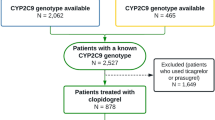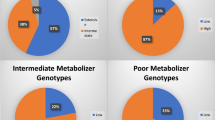Abstract
Background
The relationship between CYP2C19*2 gene polymorphism and clopidogrel resistance reflected by platelet function assays has been studied extensively in the past several years, while no clear conclusion can be drawn from the previous studies. To explore a more precise estimation of the relationship, a meta-analysis was conducted in the present study.
Methods
The relevant studies were identified by searching PubMed, EMBASE, the Web of Science, Cochrane Collaboration Database, Chinese National Knowledge Infrastructure (CNKI), Wanfang Database, and China Biological Medicine (CBM) up to February, 2014. The meta-analysis was performed by the STATA 11.
Results
Eight studies with a total of 2,331 subjects, including 1,066 patients with clopidogrel resistance and 1,265 patients without clopidogrel resistance were included. The pooled analysis showed that CYP2C19*2 gene polymorphism was probably associated with clopidogrel resistance (OR (95 % CI): GA vs. GG: 2.10 (1.74–2.53); AA vs. GG: 3.05 (2.10–4.45); dominant model: 2.22 (1.85–2.65); recessive model: 2.33 (1.62–3.36)). No statistically significant difference was found in the analysis of the three subgroups. The statistical stability and reliability was also demonstrated by the sensitivity analysis and publication bias outcomes.
Conclusion
The meta-analysis suggests that CYP2C19*2 gene polymorphism may be associated with clopidogrel resistance.





Similar content being viewed by others
References
Mehta SR, Yusuf S, Peters RJ et al (2001) Effects of pretreatment with clopidogrel and aspirin followed by long-term therapy in patients undergoing percutaneous coronary intervention: the PCI-CURE study. Lancet 358:527–533
Steinhubl SR, Berger PB, Mann JT 3rd et al (2002) CREDO Investigators. Clopidogrel for the reduction of events during observation. Early and sustained dual oral antiplatelet therapy following percutaneous coronary intervention: a randomized controlled trial. JAMA 288:2411–2420
Born GV (1985) Adensine diphosphate as a mediator of platelet aggregation in vivo: an editorial view. Circulation 72:741–746
Savi P, Pereillo JM, Uzabiaga MF et al (2000) Identification and biological activity of the active metabolite of clopidogrel. Thromb Haemost 84:891–896
Herbert JM, Savi P (2003) P2Y12, a new platelet ADP receptor, target of clopidogrel. Semin Vasc Med 3:113–122
Farid NA, Kurihara A, Wrighton SA (2010) Metabolism and disposition of the thienopyridine antiplatelet drugs ticlopidine, clopidogrel, and prasugrel in humans. J Clin Pharmacol 50:126–142
Lins R, Broekhuysen J, Necciari J et al (1999) Pharmacokinetic profile of 14C-labeled clopidogrel. Semin Thromb Hemost 25:29–33
Heestermans AA, van Werkum JW, Schömig E et al (2006) Clopidogrel resistance caused by a failure to metabolize clopidogrel into its metabolites. J Thromb Haemost 4:1143–1145
Wu H, Qian J, Sun A et al (2012) Association of CYP2C19 genotype with periprocedural myocardial infraction after uneventful stent implantation in Chinese patients receiving clopidogrel pretreatment. Circ J 76:2773–2778
Park KJ, Chung HS, Kim SR et al (2011) Clinical, pharmacokinetic, and determinants of clopidogrel resistance in Korean patients with acute coronary syndrome. Korean J Lab Med 31:91–94
Kreutz RP, Owens J, Jin Y et al (2013) Cytochrome P450 3A4*2, PPAR-α, and ARNT polymorphisms and clopidogrel response. Clin Pharmacol 5:185–192
Barsky AA, Arora RR (2006) Clopidogrel resistance: myth or reality? J Cardiovasc Pharmacol Ther 11:47–53
Holmes MV, Perel P, Shah T et al (2011) CYP2C19 genotype, clopidogrel metabolism, platelet function, and cardiovascular events: a systematic review and meta-analysis. JAMA 306:2704–2714
Sofi F, Giusti B, Marcucci R et al (2011) Cytochrome P450 2C19*2 polymorphism and cardiovascular recurrences in patients taking clopidogrel: a meta-analysis. Pharmacogenomics J 11:199–206
Mega JL, Simon T, Collet JP et al (2010) Reduced-function CYP2C19 genotype and risk of adverse clinical outcomes among patients treated with clopidogrel predominantly for PCI: a meta-analysis. JAMA 304:1821–1830
Mao L, Jian C, Changzhi L et al (2013) Cytochrome CYP2C19 polymorphism and risk of adverse clinical events in clopidogrel-treated patients: a meta-analysis based on 23,035 subjects. Arch Cardiovasc Dis 106:517–527
Lev EI, Patel RT, Maresh KJ et al (2006) Aspirin and clopidogrel drug response in patients undergoing percutaneous coronary intervention: the role of dual drug resisitance. J Am Coll Cardiol 47:27–33
Liu XL, Wang ZJ, Yang Q et al (2010) Impact of CYP2C19 polymorphism and smoking on response to clopidogrel in patients with stable coronary artery disease. Chin Med J 123:3178–3183
Gurbel PA, Bliden KP, Zaman KA et al (2005) Clopidogrel loading with eptifibatide to arrest the reactivity of platelets: results of the Clopidogrel Loading with Eptifibatide to Arrest the Reactivity of Platelets (CLEAR PLATELETS) study. Circulation 111:1153–1159
Bliden KP, DiChiara J, Tantry US et al (2007) Increased risk in patients with high platelet aggregation receiving chronic clopidogrel therapy undergoing percutaneous coronary intervention: is the current antiplatelet therapy adequate? J Am Coll Cardiol 49:657–66614
Barragan P, Bouvier JL, Roquebert PO et al (2003) Resistance to thienopyridines: clinical detection of coronary stent thrombosis by monitoring of vasodilator-stimulated phosphoprotein phosphorylation. Catheter Cardiovasc Interv 59:295–302
Bonello L, Paganelli F, Arpin-Bornet M et al (2007) Vasodilator-stimulated phosphoprotein phosphoprylation analysis prior to percutaneous coronary intervention for exclusion of postprocedural major adverse cardiovascular events. J Thromb Haemost 5:1630–1636
Lee JM, Park S, Shin DJ et al (2009) Relation of genetic polymorphism in the cytochrome P450 gene with clopidogrel resistance after drug-eluting stent implantation in Koreans. Am J Cardiol 104:46–51
Tang XF, Wang J, Zhang JH et al (2013) Effect of the CYP2C19 2 and 3 genotypes, ABCB1 C3435T and PON1 Q192R alleles on the pharmacodynamics and adverse clinical events of clopidogrel in Chinese people after percutaneous coronary intervention. Eur J Clin Pharmacol 69:1103–1112
Frere C, Cuisset T, Morange PE et al (2008) Effect of cytochrome P450 polymorphisms on platelet reactivity after treatment with clopidogrel in acute coronary syndrome. Am J Cardiol 101:1088–1093
Stang A (2010) Critical evaluation of the Newcastle-Ottawa scale for the assessment of the quality of nonrandomized studies in meta-analyses. Eur J Epidemiol 25:603–605
Higgins JP, Thompson SG, Deeks JJ et al (2003) Measuring inconsistency in meta-analyses. BMJ 327:557–560
Duval S, Tweedie R (2000) Trim and fill: a simple funnel-plot-based method of testing and adjusting for publication bias in meta-analysis. Biometrics 56:455–463
Hong DD (2009) Influence of cytochrome P450 enzyme (CYP2C19 and CYP3A5) polymorphism on clopidogrel responsiveness in coronary atherosclerotic heart disease patients: [D]. Fujian medical university, Fujian [Chinese]
Bonello-Palot N, Armero S, Paganelli F et al (2009) Relation of body mass index to high on-treatment platelet reactivity and of failed clopidogrel dose adjustment according to platelet reactivity monitoring in patients undergoing percutaneous coronary intervention. Am J Cardiol 104:1511–1515
Chen H, Yan W, Wu XY et al (2010) Relationships of blood stasis syndrome, CYP2C19 gene polymorphism with clopidogrel resistance and post-PCI prognosis. CJITWM [Chin] 30:1245–1249
Bonello L, Armero S, Ait Mokhtar O et al (2010) Clopidogrel loading dose adjustment according to platelet reactivity monitoring in patients carrying the 2C19*2 loss of function polymorphism. J Am Coll Cardiol 56:1630–1636
Cuisset T, Quilici J, Cohen W et al (2011) Usefulness of high clopidogrel maintenance dose according to CYP2C19 genotypes in clopidogrel low responders undergoing coronary stenting for non ST elevation acute coronary syndrome. Am J Cardiol 108:760–765
Hwang SJ, Jeong YH, Kim IS et al (2011) The cytochrome 2C19*2 and *3 alleles attenuate response to clopidogrel similarly in East Asian patients undergoing elective percutaneous coronary intervention. Thromb Res 127:23–28
Zhao Q (2012) The association between CYP2C19*2 gene polymorphisms and clopidogrel resistance in the Han population of North China with coronary atherosclerotic heart disease: [D]. Hebei Medical University, Hebei [Chinese]
Zhang L, Chen Y, Jin Y et al (2013) Genetic determinants of high on-treatment platelet reactivity in clopidogrel treated Chinese patients. Thromb Res 132:81–87
Müller I, Besta F, Schulz C et al (2003) Prevalence of clopidogrel non-responders among patients with stable angina pectoris scheduled for elective coronary stent placement. Thromb Haemost 89:783–787
Mobley JE, Bresee SJ, Wortham DC et al (2004) Frequency of nonresponse antiplatelet activity of clopidogrel during pretreatment for cardiac catheterization. Am J Cardiol 93:456–458
Matetzky S, Shenkman B, Guetta V et al (2004) Clopidogrel resistance is associated with increased risk of recurrent atherothrombotic events in patients with acute myocardial infarction. Circulation 109:3171–3175
Järemo P, Lindahl TL, Fransson SG et al (2002) Individual variations of platelet inhibition after loading doses of clopidogrel. J Intern Med 252:233–238
Bonello L, Tantry US, Marcucci R et al (2010) Consensus and future directions on the definition of high on-treatment platelet reactivity to adenosine diphosphate. J Am Coll Cardiol 56:919–933
Qureshi Z, Hobson AR (2013) Clopidogrel “resistance”: where are we now? Cardiovasc Ther 31:3–11
Terpening C (2010) Clopidogrel: a pharmacogenomic perspective on its use in coronary artery disease. Clin Med Insights Cardiol 4:117–128
Acknowledgments
We are really appreciative of all the participants in this study.
Conflict of interest
None declared.
Author information
Authors and Affiliations
Corresponding author
Rights and permissions
About this article
Cite this article
Hou, X., Shi, J. & Sun, H. Gene polymorphism of cytochrome P450 2C19*2 and clopidogrel resistance reflected by platelet function assays: a meta-analysis. Eur J Clin Pharmacol 70, 1041–1047 (2014). https://doi.org/10.1007/s00228-014-1714-x
Received:
Accepted:
Published:
Issue Date:
DOI: https://doi.org/10.1007/s00228-014-1714-x




